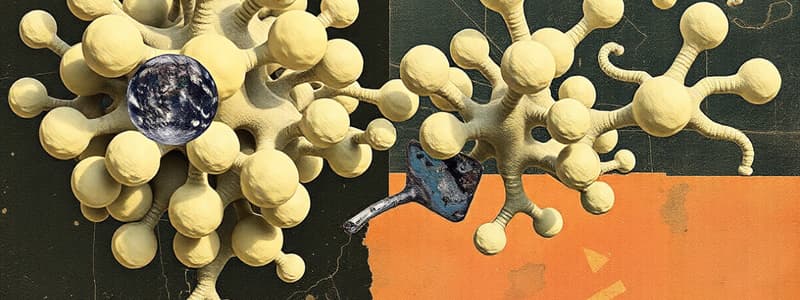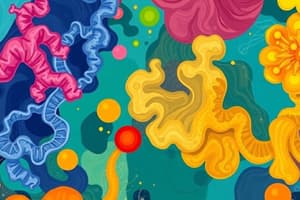Podcast
Questions and Answers
What structural form do collagen molecules take to provide tensile strength?
What structural form do collagen molecules take to provide tensile strength?
- Random coil
- Single polypeptide chain
- Triple helix (correct)
- Double helix
Which amino acid is repeated every third position in collagen's polypeptide chains?
Which amino acid is repeated every third position in collagen's polypeptide chains?
- Proline
- Serine
- Alanine
- Glycine (correct)
What type of bonds hold the collagen polypeptides together in its triple helix structure?
What type of bonds hold the collagen polypeptides together in its triple helix structure?
- Peptide bonds
- Ionic bonds
- Disulfide bonds
- Hydrogen bonds (correct)
What is the main function of hemoglobin in the blood?
What is the main function of hemoglobin in the blood?
What distinguishes HDL from LDL in terms of cholesterol transport?
What distinguishes HDL from LDL in terms of cholesterol transport?
What role do glycoproteins play in the body?
What role do glycoproteins play in the body?
How are lipoproteins formed in the body?
How are lipoproteins formed in the body?
What characterizes the metabolic process of LDL in the body?
What characterizes the metabolic process of LDL in the body?
What structural characteristic of collagen helps prevent weak spots in its fibrils?
What structural characteristic of collagen helps prevent weak spots in its fibrils?
What maintains the water solubility of hemoglobin?
What maintains the water solubility of hemoglobin?
What is the primary reason for the solubility of globular proteins in water?
What is the primary reason for the solubility of globular proteins in water?
Which structural feature is characteristic of fibrous proteins?
Which structural feature is characteristic of fibrous proteins?
What happens to globular proteins if their 3D shape is slightly altered?
What happens to globular proteins if their 3D shape is slightly altered?
How do peptide bonds form between amino acids?
How do peptide bonds form between amino acids?
What is a key difference between globular and fibrous proteins?
What is a key difference between globular and fibrous proteins?
Which amino acid feature is crucial for the specific folding of protein structures?
Which amino acid feature is crucial for the specific folding of protein structures?
What role do disulfide bonds play in proteins?
What role do disulfide bonds play in proteins?
What type of bonds primarily facilitate the secondary structure of proteins?
What type of bonds primarily facilitate the secondary structure of proteins?
In what way do globular proteins interact within the cytoplasm?
In what way do globular proteins interact within the cytoplasm?
Which of the following best describes the tertiary structure of proteins?
Which of the following best describes the tertiary structure of proteins?
Flashcards are hidden until you start studying
Study Notes
Types of Proteins
Globular Proteins
- Characterized by a spherical shape and water solubility.
- Hydrophilic polar R groups face outward, facilitating hydrogen bonding with water, while hydrophobic R groups point inward.
- Exhibit tertiary structure with a specific 3D shape, often resulting in metabolic activity; some have quaternary structure.
- Sensitive to environmental changes; slight alterations in shape can lead to loss of function.
- Form colloids in solution rather than true solutions due to large molecular size, suspending in cytoplasm.
- Essential for maintaining molecular arrangement within cells.
- Examples include hemoglobin, myoglobin, insulin, antibodies, and enzymes.
Protein Structure Formation
- Peptide bonds form between the amino group of one amino acid and the carboxyl group of another.
- The primary structure consists of the sequence of amino acids in the polypeptide chain.
- R group position, orientation, and bond types (e.g., disulfide and hydrogen bonds) influence protein folding.
- Folding leads to secondary and tertiary structures, creating functional active sites.
- Hydrophilic amino acids orient outward while hydrophobic ones orient inward, affecting solubility.
- Enzymes are a specific example of globular proteins with distinct tertiary structures and active sites.
Fibrous Proteins
- Have a simpler structure lacking tertiary formation, with polypeptides aligned parallel for stability.
- Form long strands of polypeptide chains interlinked by cross-links, enhancing resilience to temperature and pH changes.
- Generally water insoluble and consist of repetitive amino acid sequences.
- Serve a structural role due to their toughness and strength.
- Examples include keratin (in hair, nails, and skin) and collagen (in artery walls).
Collagen Adaptations and Functions
- An insoluble fibrous protein found in tendons, cartilage, bones, teeth, and blood vessel walls.
- Composed of three polypeptide chains in a helical structure, each approximately 300 nm long and 1000 amino acids in length.
- Glycine, the smallest amino acid, occurs at every third position, aiding structural integrity.
- Three helical chains form a triple helix, reinforced by numerous hydrogen bonds and covalent cross-links.
- Staggered arrangement of parallel molecules prevents weak spots along fibrils.
- Groups of fibrils align to create strong bundles called fibers, granting high tensile strength to collagen.
Conjugated Proteins
- Comprise protein molecules associated with prosthetic groups not derived from amino acids.
- Hemoglobin is a key example, featuring a globular structure with four polypeptide chains (2 alpha and 2 beta).
- Each chain contains a heme group, allowing a single hemoglobin molecule to carry four oxygen molecules.
- Lipoproteins, formed by conjoining proteins and lipids (e.g., triglycerides), are crucial for cholesterol transport in blood.
- Low-Density Lipoproteins (LDL) carry cholesterol to cells, while excess LDL can lead to artery narrowing.
- High-Density Lipoproteins (HDL) transport excess cholesterol back to the liver for breakdown and removal, comprising more protein than LDL, making them denser.
Glycoproteins
- Characterized by the presence of carbohydrate prosthetic groups, enhancing water retention and resistance to enzymatic digestion.
- Examples include mucus and synovial fluid, essential for reducing friction and protecting protein walls from digestive enzymes, particularly in the stomach.
Studying That Suits You
Use AI to generate personalized quizzes and flashcards to suit your learning preferences.



